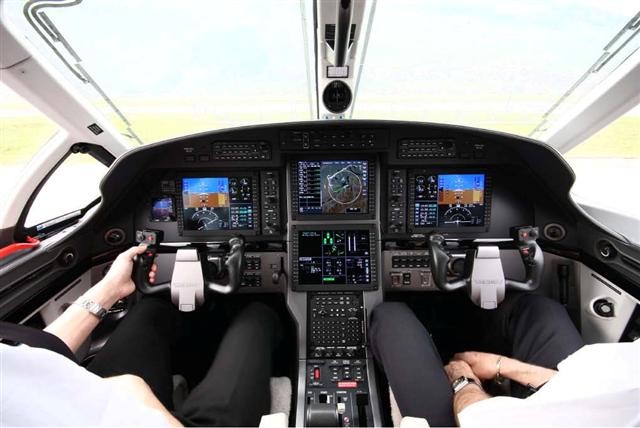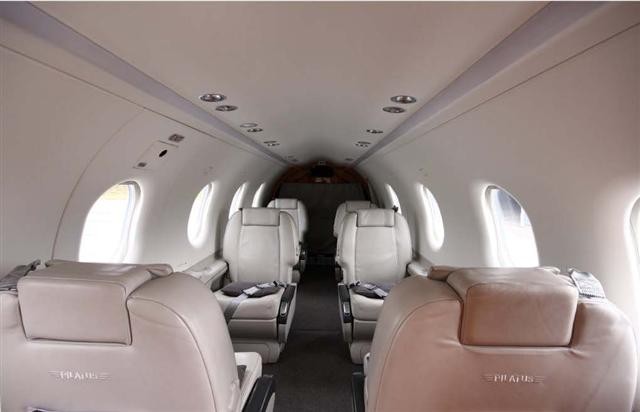


Aircraft Description
Background/History
Pilatus has been building single-engine aircraft in Stans, Switzerland for nearly 70 years. Pilatus showed a mock-up of their single-engine turboprop PC-12 in 1989. The new aircraft was a large single-engine utility aircraft to serve such roles as small-package delivery and short-range business travel. The PC-12’s first flight in May 1991 demonstrated a level of performance that exceeded its major competitor, the Cessna Caravan, in range, cruise speed, and climb rate. The PC-12 has the short-field capability that was the hallmark of Pilatus’ earlier PC-6 Porter and Turbo Porter series. Unlike the PC-6, the sophisticated PC-12 is a sleek low-wing monoplane with retractable gear. Its role as a utility plane was somewhat disguised by the jet-like appearance of its T-tail and winglets, its swift speeds, and its high-tech EFIS and avionics suite. The Pilatus PC-12 received FAA certification in July 1994, and by December 2000 more than 253 examples were flying with production continuing at a steady rate. There were 673 PC-12 aircraft produced through 2006. One hundred fifteen of the higher gross weight PC-12/47 were produced in 2007and 2008. Deliveries of the PC-12/47E or PC-12 NG began shortly after its certification in March of 2008. The PC-12 NG features a number of significant improvements over its predecessor, including a fully integrated Honeywell Primus Apex avionics system, a completely revised cockpit designed by BMW Group Designworks USA, and a more powerful Pratt & Whitney Canada PT6A-67P engine.
Power
The PC-12 is powered by a Pratt & Whitney Canada PT6A-67P turboprop engine flat-rated to 1,200shp at takeoff to ISA +36C (takeoff thermodynanic power of 1,744 shp). The four-bladed, constant-speed metal propeller is built by Hartzell and is full-feathering and reversible. Engine inspection interval is 3,500 hours.
Avionics
The PC-12 NG features state-of-the-art Honeywell Primus Apex integrated Avionics System and a Honeywell digital autopilot. Four 10.4-inch displays, two PFDs, one for the pilot and one for the copilot (the PC-12 is a single-pilot airplane that needs no type rating, and the copilot’s display is technically optional) and two MFDs, provide integrate flight information, engine monitoring, aircraft configuration, pressurization, and environmental controls. Flight and weather data, charts, aircraft system information, and trip planning functions are all within easy reach. The control for the software is through the system’s joystick, cursor control device (CCD). The PFDs are conventional looking, featuring a typical split HSI/ADI display with tape-style airspeed and vertical speed displays along the sides. Electronic charts and XM Weather weren’t finished in time for certification but should be ready before the end of 2008.
Design Features
The Pilatus PC-12 is a single-engine turboprop powered, pressurized, business/utility aircraft configured as a cantilever low-wing monoplane with a cantilever T-tail. The retractable tricycle landing gear utilizes trailing-link main gear struts, and has a single wheel on each unit. The airframe is constructed primarily of aluminum, but composite materials are used for some components. In addition to the typical airstair door just aft of the flight deck, a port-side cargo door measuring 52″ x 53″ is located aft of the wing. Operational features include automatic torque limiting, automatic fuel load balancing, and a stall-warning stick shaker/stick.
Accomodations
The PC-12’s 330 cu ft (9.34 cu m) pressurized cabin can be configured for a variety of missions. The aircraft is offered in a standard 6, 7 or 8 passenger executive layout version with a fully enclosed forward lavatory. A high-density corporate shuttle configuration adds two additional passenger seats and the co-pilot seat on the flight deck is available if desired. Also available are a freighter version, or a combination arrangement in which the forward section of the cabin houses four or six passenger seats and a large cargo area occupies the aft section of the cabin. Cabin dimensions are 4.8ft. height, 5.0ft. width and 16.9ft. length. The baggage compartment measures 40 cu ft. A new cockpit environment designed by BMW Group Designworks USA sets a new standard for ergonomics and aesthetics.
| General | PC-12NG, PC-12/47E | |||
|---|---|---|---|---|
| Category | Single-Engine Turboprop | |||
| Years Aircraft Manufactured | 2008 to present | |||
| Serial Number Range | 1001 (up) | |||
| Retail High Price | $3,750,000.00 / 2,942,625.00€ | |||
| Retail Low Price | $3,385,000.00 / 2,656,209.50€ | |||
| Characteristics | PC-12NG, PC-12/47E | |||
| Seating | 1+7/10 | |||
| Wing Loading | 37.6 | |||
| Power Loading | 8.7 | |||
| Noise(EPNdB): Takeoff/Sideline/Approach | 79.3 | |||
| External Dimensions (ft) | PC-12NG, PC-12/47E | |||
| External Length | 47.3 | |||
| External Height | 14.0 | |||
| External Span | 53.3 | |||
| Internal Dimensions (ft) | PC-12NG, PC-12/47E | |||
| Internal Length (Overall/Net Height) | 16.9 | |||
| Internal Height | 4.8 | |||
| Internal Width (Max/Floor) | 5.0 | |||
| Baggage | PC-12NG, PC-12/47E | |||
| External: Cu.Ft./Lb. | N/A | |||
| External: Cu.Ft./Lb. | N/A | |||
| Power | PC-12NG, PC-12/47E | |||
| Engines | P&WC PT6A-67P | |||
| Output (lbs ea.)/Flat Rating | 1200/ISA+35C | |||
| Inspection Interval | 3500t | |||
| Data based on latest manufactured year | ||||



